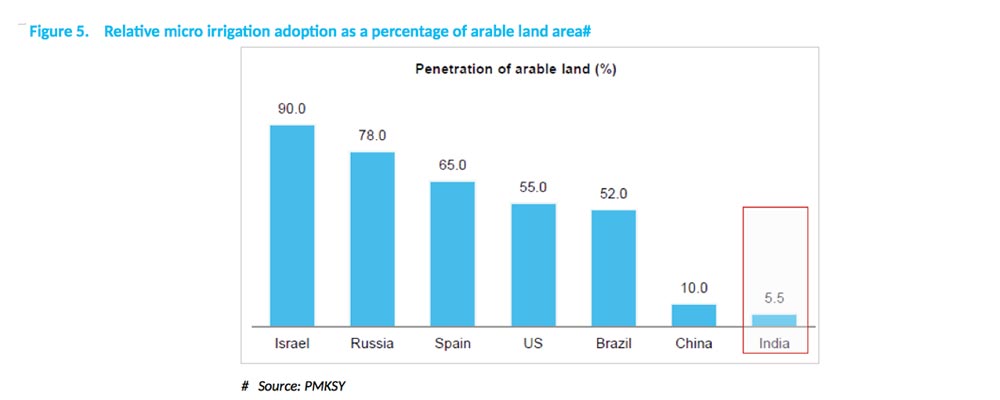Welcome to Jain Irrigation Systems Ltd.

Blog at Jains - Drip-Fertigation Technology for Sustainable Crop Production
Water and Irrigation scenario in India.
Over the years water has become the most critical resource for agriculture , gaining primacy even over soil. One can raise crops in soil-less medium that still require water! With only 4 % of World’s fresh water, Indian Agriculture is highly depended on rain fall. Rain depended crop production has limited its scope for high yields and adoption of high yield generating factors. The low crop yields in rain-fed agriculture underlines the importance of irrigation.
In a simple analysis, the picture is as follows: India grows crops on a gross land surface of 195.8 million ha ( with net area 140.9 million ha and 55.0 million ha with crops grown more than once) (Min. Agri. Directorate of Economics & Statistics); while the ultimate irrigation potential (if developed) is 139.9 million ha (Central Water Commission). The country will NEVER have complete irrigation cover for all the gross cropped area unless we do something about the way water is consumed for irrigation.
The actual status is not that simple and direct. Though the net irrigated area steadily increased from 1950-60 till present, the growth rates estimated every 10 years started dropping after 1990. There are various reasons like lower public investment to less attention to rehabilitation of irrigation schemes of the past etc. But the major issue is found to be a failure in effectively managing the water resources. Management and maintenance of irrigation canal net works and field channels is becoming a major challenge for institutions. The net result is lower irrigation efficiencies resulting in a situation where expansion of irrigation to more land surface is difficult.
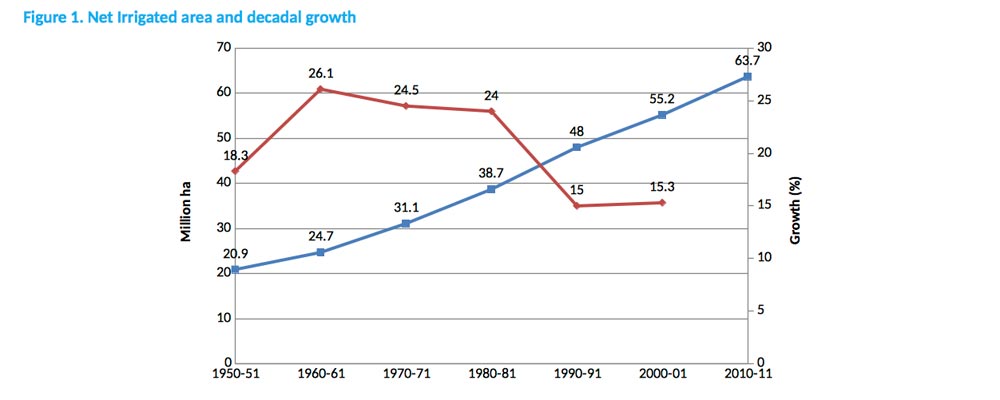
It is with the persistent belief that appropriate incursions to effectively manage existing irrigation water resources that the government of India now started focusing on converting irrigation to micro irrigation (drip and sprinkler). Years of field work and patient presentations to the government departments dealing with water and agriculture has paved the way for the single point realization that micro irrigation, helps in increasing water use efficiency in irrigation. Indian farmers have repeatedly shown that adoption of drip irrigation, for example results in yield enhancement and lower water and energy use. This is not only a win-win situation but forges ahead with the practical demonstration of sustainability; more production with lesser resources. Additionally, as irrigation uses 78% of the fresh water resources of the country, increasing the efficiency of irrigation water use is the primary objective in conservation of water resources.
Drip irrigation associated technologies for crop production
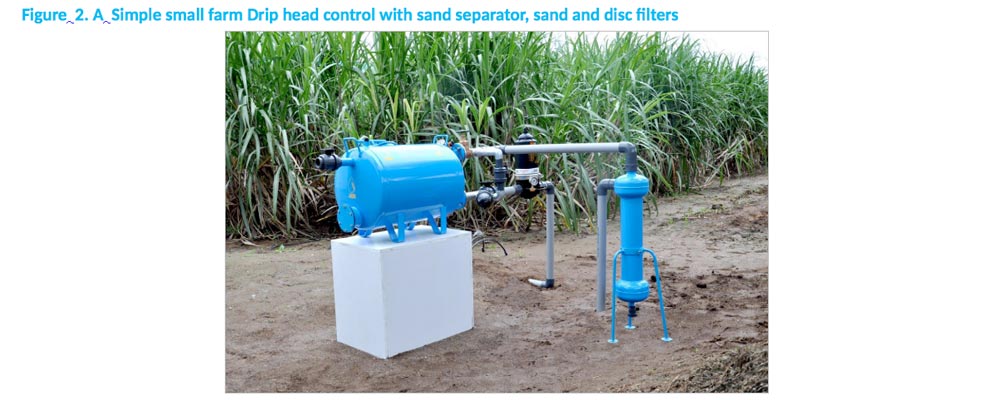
The current awareness level of drip irrigation in the country is high; even the respected prime minister of the country reiterates its positive role in increasing water use efficiency at every opportunity he gets. This level of awareness has come over a long period of time, some 25 years or so during which the technology of drip irrigation underwent a number of changes both in the material components assembled as an irrigation system and the scientific knowledge of management of water, fertilizer, and other chemicals in crop production. The scientific information available on crop water requirements, plant nutrient requirements, both in terms of growth time (when) and type (what) were available in publications for years, suddenly found a methodology and instrumentation of precision so that even a small farmer in a remote village can do irrigation and fertigation with efficiency of water consumption. Did any one, the irrigation expert, the extension person, or the farmer ever considered crop water requirement while irrigating a crop in the conventional scenario? That is the change.
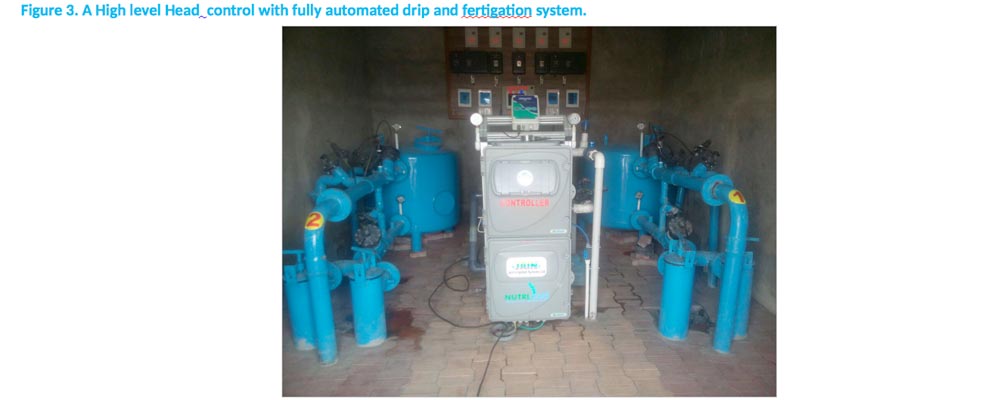
Technology has now come up with drippers that need lower quantities of raw material and more precision and lower clogging opportunities. So are the control systems ensuring acute precision in the delivery of water, fertilizer and other chemicals directly to the rhizosphere, even placing them below the soil surface. And this progression is not ending there; research and development continues. The benefits of such efficient delivery systems are there everyone to see.
Precision breeds efficiency. Here in the field of irrigation , fertilizer application, chemical application , other agronomic actions, processes once thought as very “casual” activities and not taken as “life threatening” always exemplifying a lack of application and commitment. The commitment of a successful surgeon is generally not to be found elsewhere in other human activity areas like crop production and management. Now we are in an era, where such levels of efficiencies are required in every activity including agriculture.
Drip irrigation is not about water delivery alone. One of the major co-evolved science is the application of fertilizers through the drip systems. The equipment part of this evolution could easily be solved by addition of simple ventury, or a fertilizer tank, or any one high precision injectors. The science of fertigation took more time and efforts to develop in terms of application of nutrients as per requirement of the crop; the scheduling of fertigation. Historically, it started with just increasing the frequency of application from original one or two (splits) during the life span of the crop to many as convenient. But the real knowledge of each nutrient and its role in the crop growth and development was not looked as a field applicable issue. With the arrival of drip irrigation system with fertilizer applicator helped in enhancing the precision in terms of meeting the requirement per se, and requirement time (during crop life) and the essentiality of different nutrient types to match with physiological progress during crop growth. Now as we dwell on this issue, there are very effective fertigation schedules (what, when and how much of nutrient) those are scientifically tested and made available to farmers.
Drip technology enhances crop yield
One of the very positive benefit to a farmer from adopting drip irrigation is the direct yield enhancement of the crop; a factor that has been proved in India in almost all the crops, both horticultural and agricultural. These yield improvements are noted by research institutions and universities also. We at Jain irrigation have been monitoring our client farmers’ crops and collecting data over a number years. The following table (Table 1 ) depicts the performance of 45 different crops to drip irrigation or related other micro irrigation systems adopted by the farmers of various states of the country.
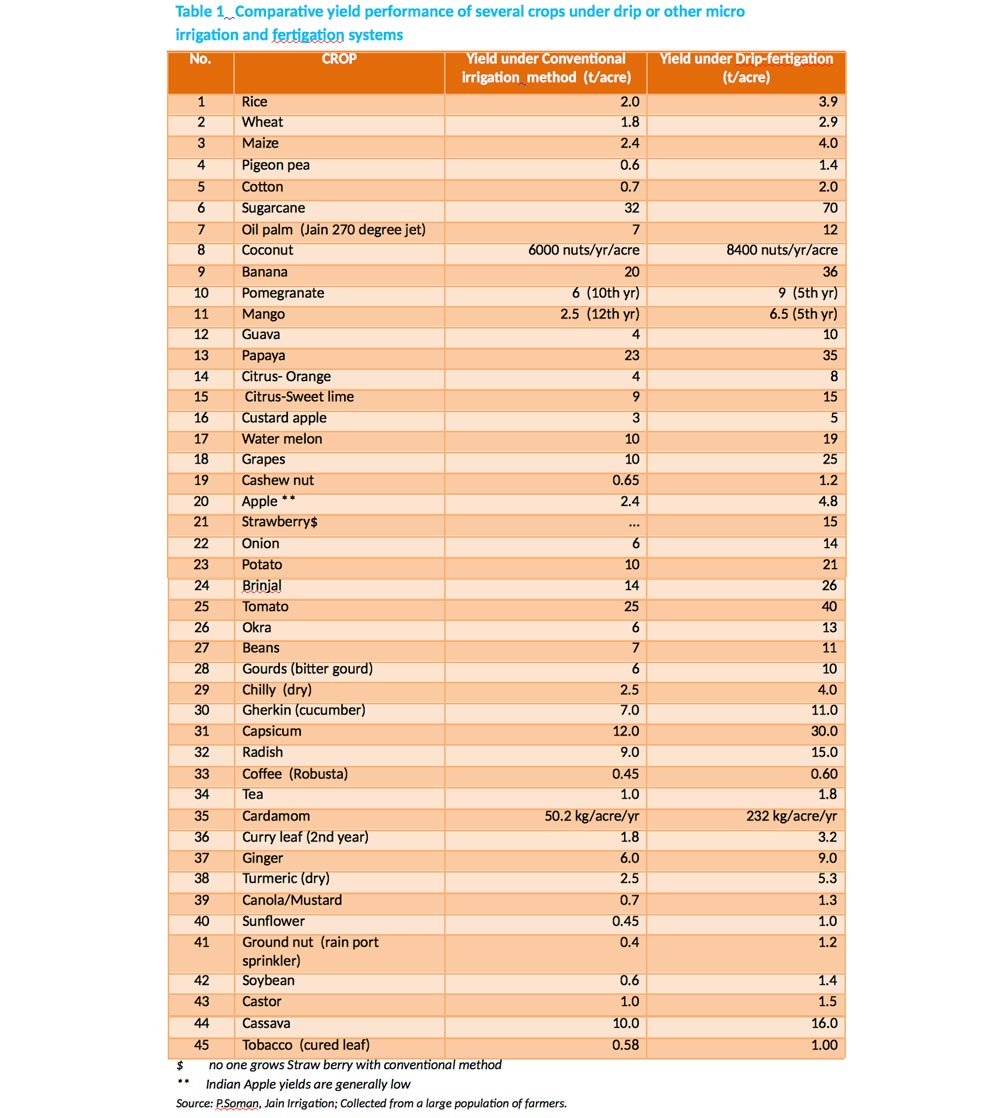
The above table unequivocally establishes the yield benefit due to proper application of drip irrigation technology. Drip irrigation actually acted as a catalyst in these cases. Along with drip or micro irrigation , the farmer is trained to adopt high tech methods in every aspect of crop agronomy and crop management. Changing crop varieties, use of improved seed/seedling, changing crop geometry , practicing fertigation and efficient and need based pest management methods and finally effective post- harvest practices ; all these helped to enhance crop productivity. The business of drip irrigation brought to the small farmers’ fields trained and experienced crop experts and they supplemented the efforts of public extension system. All these efforts proved to be successful and crop performances soared to a higher level.
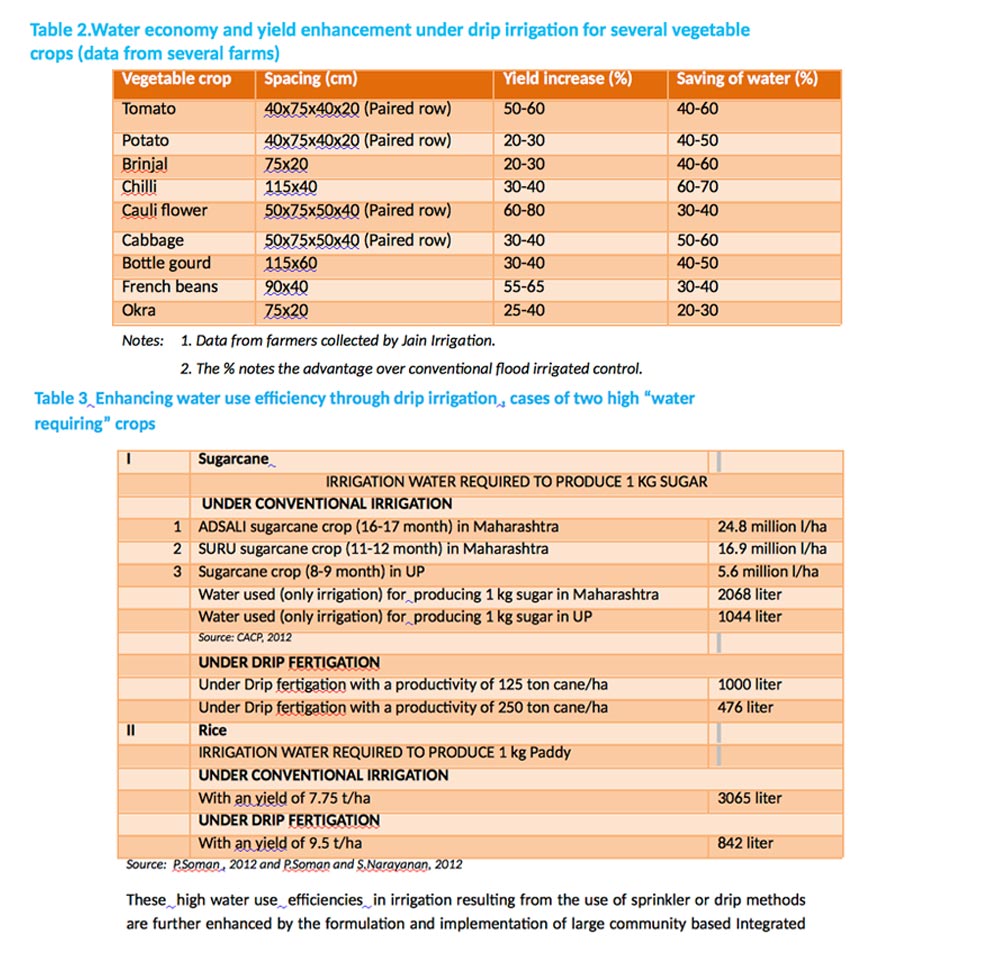
A special word about drip-fertigation technology for rice crop is relevant here. At Jains we have pioneered this technology as a mission to walk the last mile. By now we have covered 8 years of continuous work spanning all rice ecologies in India, besides Bangladesh, Turkey and Spain and co- worked with Research Institutions and Universities. Rice yields are higher than in conventional “standing water” situation and the yield benefit is in addition to the lower water and energy consumptions (respectively,66% less water and 52% less energy for pumping). The technical package is waiting in the wings to be implemented in large scale by governmental intervention, like the status of the technology for sugarcane was in early and mid 1990s. As the water stressed areas are moving at rapid pace into water scarcity (for example, the rice bowl of Tamil Nadu State) these technologies will provide necessary solutions.
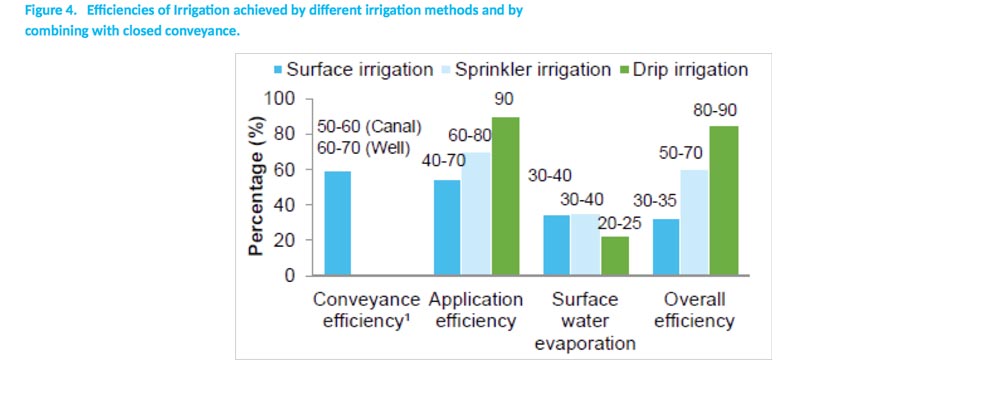
Drip technology reduces energy consumption
As the volume of water applied to irrigate a crop under drip irrigation is lower compared to that applied in conventional method, the power consumption for pumping automatically decreases. Thus in case of the Paddy crop above, drip paddy consumed only 565 units/ha as against 1167.5 units/ha consumed in the flood irrigated paddy. Table 4 below also reports on the power saving in Sugarcane production because of drip irrigation.
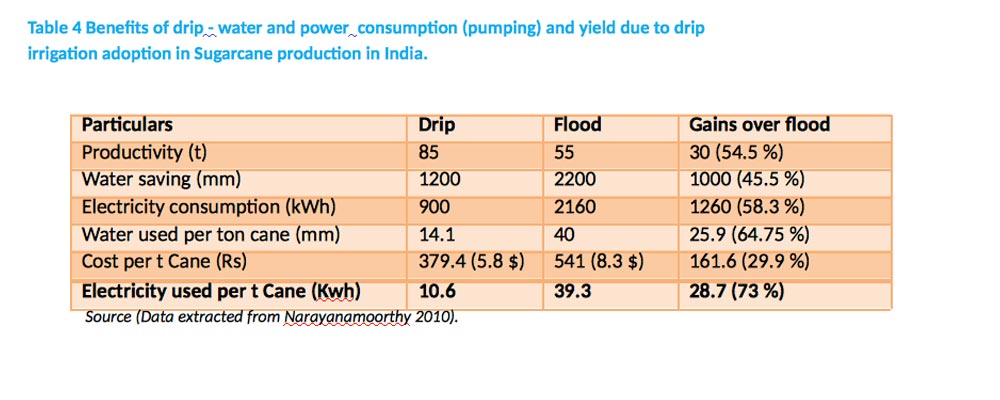
Is Drip irrigation economically viable ?
The following table illustrates the viability of an investment made for drip system. These estimates are based on the full system costs (subsidy not considered) to show that the investment on irrigation system is repayable in six months to 2 year period based on the crop and its market value. The data set represents a number of crops and varied locations. Benefits to farmers outweigh the investment cost of installation of drip system. In the last few years a number analyses by economists have been in public domain demonstrating the viability of drip irrigation (Refer to K.Palanisami et al. 2012).
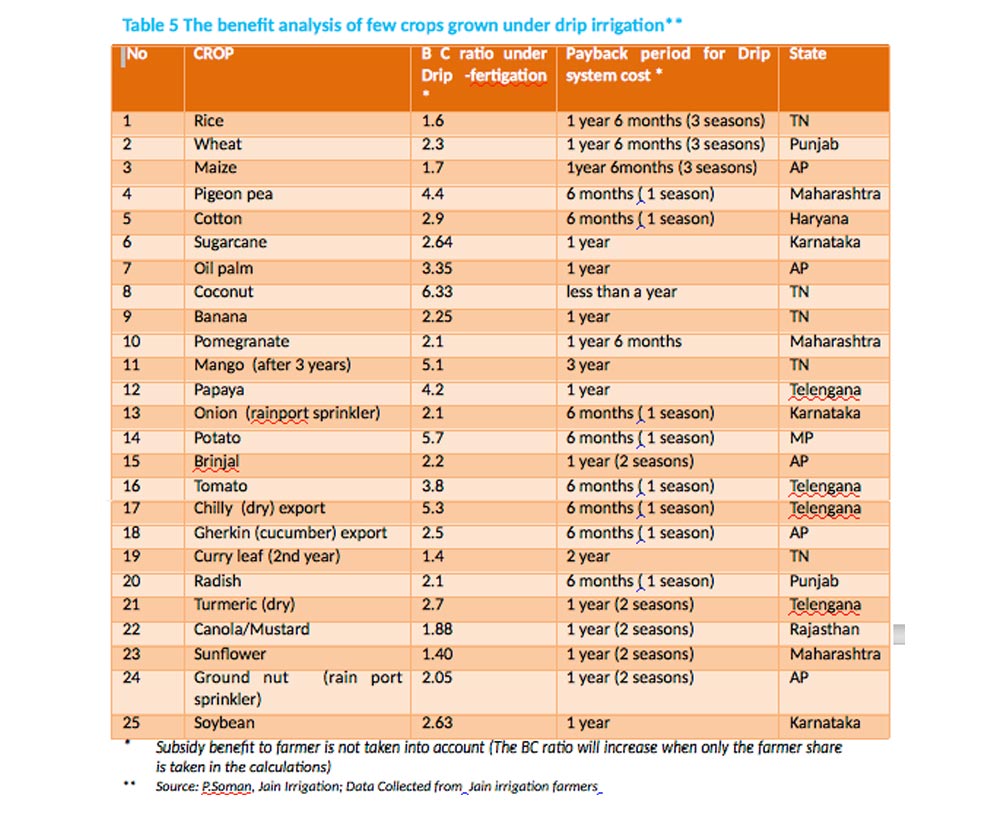
Challenges
The days when a speaker attributes low adoption rate of micro irrigation to cost, poor awareness level among farmers, system related issues etc. are far from over. The main challenge still is the public investment in providing the physical system itself to those large population of small farmers. In states like, Maharashtra, Andhra Pradesh, Gujarat, Karnataka , Madhya Pradesh, Chhattisgarh, Haryana, Punjab , Rajasthan, Tamil Nadu and Telengana, the awareness levels are relatively high and the adoption rates are also high. More active role of governments and special purpose administrative bodies (like TANHODA, GGRC, APMIP etc) of these states have certainly helped in achieving higher levels of penetration of the technology. Over the years, research by institutions, both public and private, have helped in addressing scientific issues and providing solutions, those also helped in adapting the technology to Indian farming situations. Nevertheless, the penetration of micro irrigation (as a percentage of Arable land) in India is low compared to other countries, especially, US, Brazil and China (with large Arable land areas). This becomes very critical considering, India has the largest area under irrigation cover. But in absolute terms, India has one of the largest cover of micro irrigation, 7.73 million ha ( as per PMKSY) and in the last 10 years (2005-2015) it grew by 9.6%. There is a long way to go before adoption of drip irrigation can create a perceptible country wide impact on water and power resources, besides crop production and productivity.
